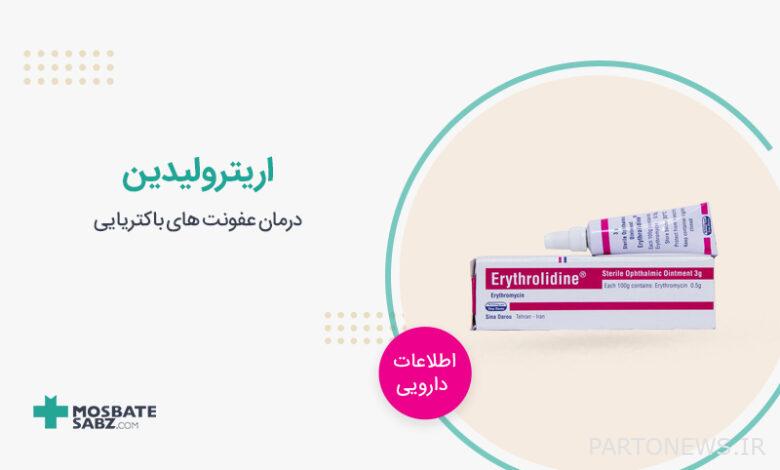What is erythrolidin and in what cases is it used?

Erythromycin ointment is used to treat eye infections and sometimes for skin problems. This ointment, which is derived from erythromycin, acts as an anti-infection. Stay with us to learn more about this ointment.
What we read in this article
Pharmaceutical forms of erythrolidin
According to the needs of patients and doctors, pharmaceutical companies produce drugs in various pharmaceutical forms and standards. In this regard, many chemical and herbal medicines are produced in different forms, such as regular tablets, chewable tablets, injection solutions, capsules, syrups, etc. Erythrolidin drug is produced in 250 mg and 500 mg tablets, 250 mg, 333 mg and 500 mg delayed release tablets, 250 mg capsules, 0.5% eye ointment and 2% topical ointment. The prescription and use of each requires a doctor’s observation and examination.
Uses of erythromycin
This medicine is used to treat some eye infections (such as conjunctivitis). It is also used to prevent some eye infections in babies and belongs to a class of drugs known as macrolide antibiotics. Erythromycin works by stopping the growth of bacteria and only treats bacterial eye infections and will not work for other eye infections. Unnecessary use or incorrect use of any antibiotic can lead to a decrease in its effectiveness. The most important uses of this product include Legionnaires’ disease, non-gonococcal urethritis, bowel preparation, pertussis, conjunctivitis and trachoma (off label).
Uses of erythromycin ointment
- conjunctivitis
- trachem (off label)
- eye infection (eye ointment)
Uses of erythromycin tablets
- Legionnaires’ disease
- Non-gonococcal urethritis
- Bowel preparation
- Lymphogranuloma Venerum
- whooping cough
- Gastroparesis (off label)
- Inguinal granuloma (off label)
- Chancroid (off label)
Pharmacological effects and mechanism of action of erythromycin drug
By binding to 50S ribosomal subunits, it inhibits protein synthesis in sensitive organisms, thereby inhibiting aminoacyl transfer and transfer-RNA, and of course it will also inhibit polypeptide synthesis. It only affects reproducing organisms. It penetrates the cell wall of Gram-positive bacteria more easily than Gram-negative bacteria. Therefore, gram-positive organisms may accumulate 100 times more erythromycin than gram-negative organisms. Absorption of erythromycin in mucous membranes is still unknown.
The dosage of erythromycin ointment
To use the eye ointment, wash your hands first. To avoid contamination, be careful not to touch the tip of the tube or allow it to touch the eye, eyelid, or any other surface. It is forbidden to use erythrolidin eye ointment before driving, working with machines and equipment. In case of use, wait for some time for the contents of the ointment to absorb into the eyes so that you do not have blurred vision while working or driving. Stopping the medication early may allow the bacteria to continue to grow, which may lead to a return of the infection. If your condition does not improve or worsens, see your doctor.
Time to use erythrolidin eye ointment
On the packaging of erythromycin ointment, the amount and time of use of the ointment for general use are listed. Apply the eye ointment to the eyes only. Do not use contact lenses while using this medicine. Sterilize contact lenses according to the manufacturer’s instructions and consult your doctor before using them again. To apply the eye ointment, tilt your head back, look up and gently pull the lower eyelid down to create a bag. Put about half an inch (1 cm) of ointment into the bag as directed by your doctor. Gently close the eye and rotate the eyeball in all directions to distribute the medicine.
Dosage of erythrolidin ointment
- Ointment of this medicine should be used to treat conjunctivitis 25 cm in 4 to 12 hours depending on the severity of the infection.
- To treat trachoma, apply a sufficient amount every 12 hours for 2 months.
- The topical ointment of this medicine can also be used to treat acne vulgaris locally (morning and evening) on the affected areas after thorough washing and drying of the skin.
Dosage of erythrolidin tablets
- To treat Legionnaire’s disease, 1-4 grams per day should be taken for 21 days.
- Non-gonococcal urethritis 500 mg every 6 hours for 7 days.
- In order to prepare the bowel, one gram is prescribed at 13:00, 2:00 and 23:00 days before surgery along with PO neomycin and mechanical cleaning of the large intestine.
- Lymphogranuloma Venrom 500 mg every 6 hours for 21 days.
- To treat whooping cough, take 500 mg every 6 hours for 14 days.
- Treatment of gastroparesis 250-500 mg three times a day before meals.
- Inguinal granuloma is prescribed 500 mg 4 times a day for 21 days.
- Chancoroid should be taken 500 mg 3 times a day for 7 days.
Precautions
Before using erythromycin ointment or tablets, if you are allergic to the components of this drug and other macrolide antibiotics (such as clarithromycin), refuse to use it. This product may contain inactive ingredients that can cause allergic reactions or other problems. After using eye ointment in some patients, we see blurred vision for a limited period of time.
During pregnancy, this drug should be used only if needed. Although many risks of eye ointment have not been reported in pregnant women and fetuses, it should be used during pregnancy with a doctor’s prescription.
- Liver dysfunction including elevated liver enzymes, hepatocellular or cholestatic hepatitis with or without jaundice has been reported.
- Prescribing treatment in the absence of a proven, strongly suspected, or prophylactic indication of bacterial infection is unlikely to benefit the patient and increases the risk of developing drug-resistant bacteria.
- Because erythromycin is primarily eliminated via the liver, caution should be exercised when administering it to patients with hepatic impairment.
- Exacerbation of symptoms of myasthenia gravis and new onset of symptoms of myasthenic syndrome have been reported in patients treated with erythromycin.
- Infantile hypertrophic pyloric stenosis (IHPS) has been reported in infants after treatment with erythromycin.
- Long-term or repeated use of erythromycin may lead to overgrowth of non-susceptible bacteria or fungi. If severe infection occurs, erythromycin should be discontinued and appropriate therapy initiated.
- If necessary, incision and drainage or other surgical procedures should be performed along with antibiotic therapy. Observational studies in humans have reported cardiovascular abnormalities following exposure to erythromycin-containing medicinal products during early pregnancy.
Contraindications to the use of erythromycin
- Documented hypersensitivity
- Simultaneous use with terfenadine
- Concomitant use with HMG-CoA reductase inhibitors that are extensively metabolized by CYP3A4 (lovastatin or simvastatin).
- Simultaneous use of erythromycin with ergotamine or dihydroergotamine
Side effects of erythromycin
After taking eye ointment or erythromycin tablets, we see some side effects such as blurred vision, burning and pain etc. in patients. If any of these effects persist or worsen, tell your doctor or pharmacist right away. Most people who use this drug do not experience serious side effects. Using this medicine for long or frequent periods may lead to other types of eye infections, including fungal infections.
If you develop any new or worsening eye symptoms (such as pain, swelling, thick discharge, or pus), stop using the medication and contact your doctor.
- Eye irritation, pain and blurred vision (eye ointment)
- stomach ache
- anaphylaxis
- Cholestatic hepatitis
- Confusion and fever
- Indigestion, diarrhea, flatulence and nausea
- Hallucinations and headaches
- hearing loss
- Hypertrophic pyloric stenosis
- high blood pressure
- Interstitial nephritis
- Mild allergic reactions
- Nervous system effects, including seizures

Erythrolidin drug interactions
Drug interactions may change how your medications work or increase your risk of serious side effects. Patients, before going to the doctor, prepare a list of the chemical and herbal medicines you use and show it to him.
Barnidipine, bilastine, bosutinib, budesonide (systemic), smallpox vaccine, cisapride, clindamycin, amiodarone, aprepitant, astemizole, lovastatin, lomacaftor and ivacaftor, lomapron, mecitazine, mizolastine, neratinib, pazopanib, pimozide, simprovir, simvastatin, topotecan and… They cause drug interactions with erythromycin. Pregnant women and nursing mothers should not take any medicine without a doctor’s prescription, because there are many drug interactions with erythromycin tablets.
Erythrolidin (erythromycin) use during pregnancy and breastfeeding
Erythrolidin enters breast milk and can be dangerous for the baby. Lactating mothers and pregnant women should avoid taking this medicine without a doctor’s prescription.
Erythromycin ointment storage conditions
Erythromycin should be stored at room temperature away from light and moisture. Keep all chemical and herbal medicines out of the reach of children and animals. Dispose of this product properly when it has expired or is no longer needed. Avoid pouring all kinds of medicines into the toilet well, street and sewer.
A final word about erythromycin ointment
In this article from Positive Green online pharmacy magazine, we described about erythrolidin ointment. According to the positive effects of erythromycin ointment in the treatment of skin problems and based on the results of research, this substance can be introduced as a new and effective solution to maintain and improve skin health. However, it is recommended that you never consult a dermatologist before using any type of ointment.
The mechanism of action of erythromycin by binding to 50S ribosomal subunits, inhibits protein synthesis in susceptible organisms and thus inhibits aminoacyl transfer and transfer-RNA. The tablet of this drug has a wide application and should be prescribed for all kinds of diseases with the observation and examination of a doctor.
Site source: Medscape

